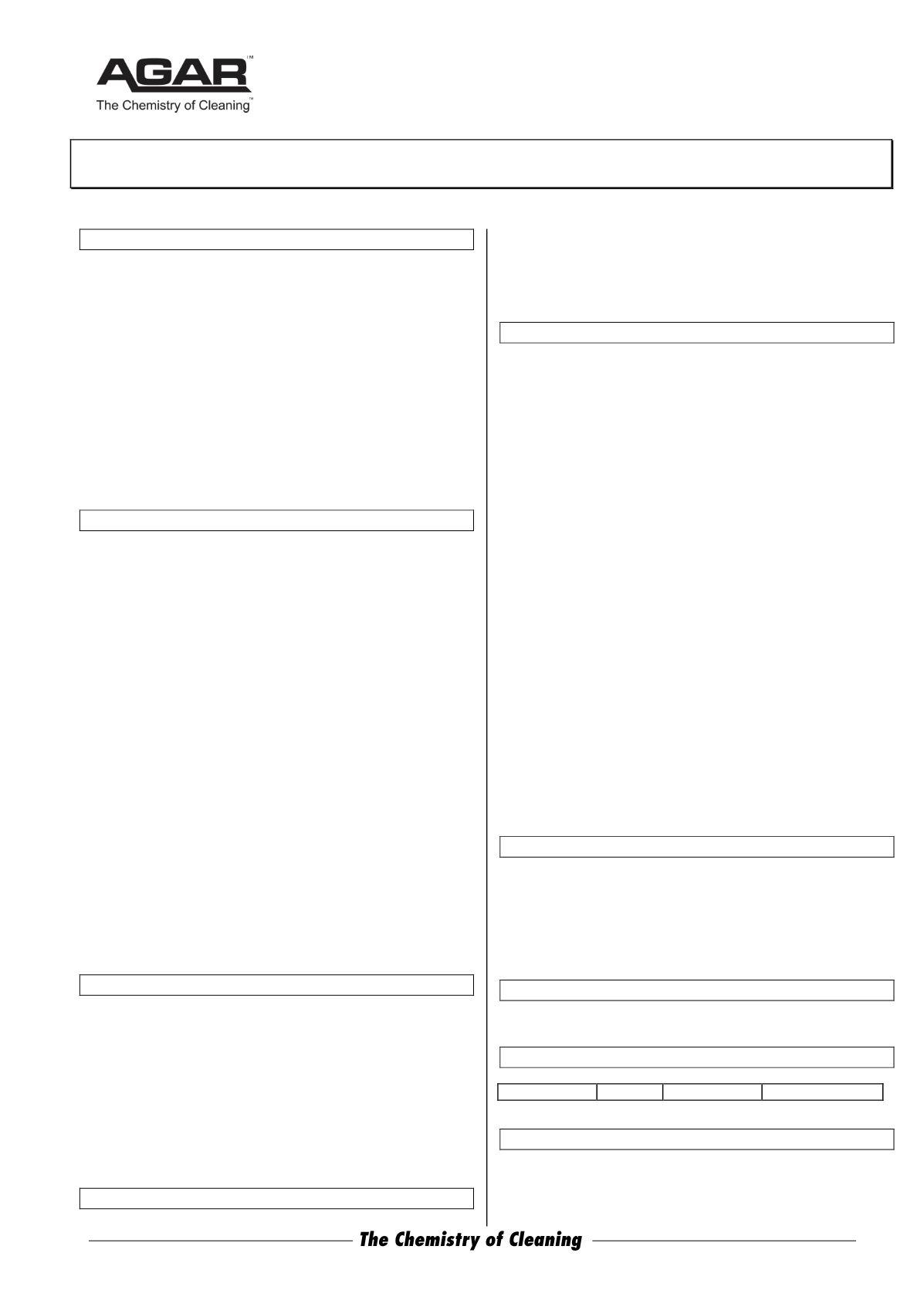

ABN 80 004 726 890 | MADE IN AUSTRALIA
Safety Data Sheet
Issued: December 18, 2015
Page 2 of 3
CHLORADET
7 HANDLING AND STORAGE
Storage and Transport: Store in a cool, dry place that is well-
ventilated and away from foodstuff containers. Direct sunlight
should be avoided.
Stability: Stable. However, heat, light, contamination with acids
or contact with metal surfaces may promote the formation of
toxic chlorine gas.
Incompatibility (Materials to avoid for purposes of transport,
handling and storage only): Avoid storage with acids, oxidising
agents, reducing agents, metals and metallic salts.
Incompatible with amines, ammonium salts, aziridine,
methanol and phenyl acetonitrile.
Class 8 Corrosives shall not be loaded with other Dangerous
Goods of Classes 1, 4.3, 5.1, 5.2, 7 or 8 (acids only) or with
foodstuffs.
8 EXPOSURE CONTROLS / PERSONAL PROTECTION
Exposure Standards: None assigned for mixture.
Atmospheric Contaminant Exposure Standard for:
Chlorine (a potential decomposition product)
CAS No. 7782-50-5 TWA = 1 ppm (3 mg/cu.m)
Peak limitation
STEL = -
Sodium hydroxide :
CAS No: 1310-73-2 TWA = - ppm (2 mg/cu.m)
Peak limitation
STEL = -
[Source: Safe Work Australia HSIS- 2015]
Engineering Controls: Mechanical ventilation: not required under
normal conditions, but local exhaust ventilation should be used
to control any air contaminants to within the Exposure
Standards.
Personal Protection:
Gloves - Wear rubber, neoprene or nitrile gloves.
Note: Resistance of glove materials can vary. Evaluate
resistance under conditions of use and maintain PPE
carefully.
Eye protection – Safety glasses should be worn.
Respiratory – If inhalation risk exists, a suitable cartridge type
Respirator should be worn.
Other – Protective overalls are desirable. An eyewash unit
should be available.
9 PHYSICAL AND CHEMICAL PROPERTIES
Appearance: Colourless thick liquid
Odour: Faint chlorine odour
pH = 12.5 +/- 0.5
Vapour Pressure: N/K
Vapour Density: N/K
Boiling Point: Approx 100
°
C
Freezing Point: < 0
°
C
Solubility in water: Infinitely miscible
Specific Gravity: 1.10
Evaporation Rate: As water
% Volatile by vol: 0% VOC
10 STABILITY AND REACTIVITY
Chloradet is corrosive to aluminium, zinc and tin. It reacts with
metal salts, peroxides and reducing agents. Do not mix with
ammonia, hydrocarbons, acids, alcohols or ethers.
No risk of hazardous polymerization.
11 TOXICOLOGICAL INFORMATION
Health Effects:
Acute -
Swallowed:
Irritating to the gastro-intestinal tract if swallowed.
May cause nausea, vomiting, headache, corrosion of mucous
membranes, esophagal or gastric perforation and laryngeal
edema.
Eye:
Eye contact may result in burns that could produce
permanent damage.
Skin:
Principal route of exposure is usually by skin contact.
Repeated or prolonged skin contact may cause swelling,
redness, blistering or dermatitis. Chloradet acts as a skin
sensitiser and may burn sensitive skin. It is not absorbed
through the skin.
Inhaled:
Overexposure to inhalation can result in coughing and
respiratory difficulty. The vapour if concentrated may irritate
the lungs. If reaction occurs to liberate chlorine (such as
accidental add mixture with acids), self-contained or air
supplied breathing apparatus will be required.
Health Effects –
Chronic:
Repeated or prolonged skin contact
may cause chronic dermatitis.
Toxicity Data: Not available for mixture.
sodium hydroxide : oral lowest lethal dose (rabbit) 500 mg/kg
(10% solution) Low systemic toxicity.
sodium hypochlorite: by ingestion, Grade 1: oral rat LD50 =
8.91 g/kg.
(Note: this data is from published information. Agar Cleaning
Systems does not carry out animal tests).
12 ECOLOGICAL INFORMATION
Ecotoxicity: Toxic to aquatic organisms.
Persistence and degradability: The surfactants in Chloradet are
readily biodegradable.
Mobility: -
Advice: Product disperses in water. Avoid contaminating
waterways.
13 DISPOSAL CONSIDERATIONS
For disposal, refer to State Land Waste Management Authority.
14 TRANSPORT INFORMATION
UN No.: 1719 Class: 8 Packg.Group: II Hazchem: 2R
15 REGULATORY INFORMATION
Poisons Schedule Number: Schedule 5.
Please turn to page 3.


















